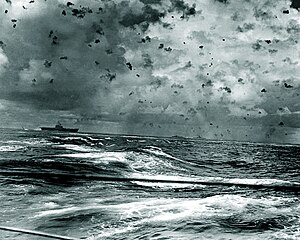1942 ⟶ Ineffective American Attacks Open the Battle of Midway
The Battle of Midway opens with ineffective attacks by land-...Year
1942
🚢 Ineffective American Attacks Open the Battle of Midway
The Battle of Midway opens with ineffective attacks by land-based American B-17s on the approaching Japanese fleet. Admiral Nagumo, in charge of the Japanese carrier force (Hiryu, Soryu, Akagi, and Kaga) is unable to locate any American aircraft carriers and decides to attack Midway's land-based air defences the first thing the next morning, which in any event is one of his planned tasks.⟶

Pacific TheaterBattle of MidwayNaval BattleAircraft CarriersJapanese FleetUS NavyAir AttacksMilitary StrategyStrategic ImportancePacific War
🚢 Coral Sea: Japanese Sink US Ships, Misled by Decoy
In the Coral Sea, Japanese search planes spot refueling ship USS Neosho and destroyer USS Sims, which have retired from Fletcher's Task Force 17 into what should have been safer waters to refuel Sims. They are mistaken for an aircraft carrier and a cruiser. Japanese Admiral Takagi, believing he has at last found the location of Fletcher's main force, orders a full out attack by carriers Shōkaku and Zuikaku and sinks both ships. This distraction helps prevent the Japanese from finding the real location of Fletcher's carriers. Meanwhile, Fletcher has a similar false alarm, the spotting of two cruisers and two destroyers being mistakenly encrypted as "two carriers and four cruisers." By chance, though, planes from USS Lexington and USS Yorktown stumble across light carrier Shōhō while pursuing the false lead and sink her, leading to the first use in the American Navy of the signal, "Scratch one flattop." Admiral Inoue is so alarmed by the loss of Shōhō he halts the Port Moresby invasion group north of the Louisiades until the American carriers can be found and destroyed.⟶

Battle of the Coral SeaNaval BattleCarrier WarfarePacific TheaterAircraft CarriersStrategic BlunderUS Navy
💥 Japanese Attack on Midway Island Begins
In the Battle of Midway, the day opens with Admiral Nagumo's attack on the air defences of the island.⟶

Pacific TheaterBattle of MidwayJapanese AttackAir DefensesMilitary CampaignNaval BattleMidway IslandUS NavyWorld War IIPacific War
💥 Battle of Midway: Day 1 - Japanese Carriers Crippled
A good deal of damage is done and many aircraft destroyed on both sides, but in the end the island's airbase is still functional. Nagumo plans a second attack on the island, and begins refueling and rearming his planes. Meanwhile, attacks are launched from all three American aircraft carriers in the area. Planes from USS Hornet, Yorktown, and Enterprise all find the targets, although most of the planes from Hornet follow an incorrect heading and miss this attack. Torpedo Squadron 8 from Hornet breaks and follows the correct heading. The Devastators of "Torp 8" are all shot down without doing any damage; there is only one survivor, George H. Gay, Jr. of Waco, Texas, who watches the battle unfold from the water. The torpedo attack fails, but draws the Japanese Combat Air Patrol down to low altitude, and they are unable to effectively repel the dive bombers from Yorktown and Enterprise when they arrive. The bombs find the Japanese flight decks crowded with fueling lines and explosive ordnance, and Akagi, Kaga, and Soryu are all soon reduced to blazing hulks, Akagi hit by only one bomb dropped by Lt. Commander Richard Halsey Best; only Hiryu escapes with no hits. Admiral Nagumo shifts his flag from Akagi to another ship, the cruiser Nagara, and orders attacks on the American carriers, one by a group of Aichi D3A dive bombers and a second by Nakajima B5N torpedo bombers. The Japanese planes find Yorktown (thinking Yorktown already sunk, the second attack group assume it must be Enterprise) and damage it so badly that Yorktown must be abandoned. Admiral Fletcher shifts his flag to cruiser Astoria and cedes operational command to Admiral Spruance. The attacks on Yorktown give away Hiryu's continued operations, though, and it is promptly attacked and will sink the next day, Admiral Yamaguchi choosing to go down with it. Of note, Hiryu and the other three destroyed Japanese carriers had participated in the attack on Pearl Harbor.⟶

Pacific TheaterNaval BattleAircraft CarriersDive BombersTorpedoesUS NavyJapanese NavyAir CombatTurning Point
🚢 Battle of Midway Ends: Japanese Fleet Devastated
The Battle of Midway comes to a close; USS Yorktown sinks; four Japanese carriers and one cruiser are sunk. The battle is viewed as a turning point in the Pacific war.⟶
Pacific TheaterNaval BattleAircraft CarriersUS NavyJapanese NavyTurning PointWorld War IIMilitary StrategyIsland Hopping
🚢 Battle of Santa Cruz: Japanese Carrier Losses
The naval Battle of Santa Cruz. The Japanese lose many aircraft and have two aircraft carriers severely damaged. USS Hornet is sunk and USS Enterprise is damaged.⟶

Pacific TheaterNaval BattleAircraft CarriersUS NavyJapanese NavySanta CruzWarshipSinking